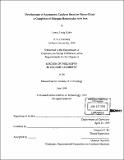| dc.contributor.advisor | Gregory C. Fu. | en_US |
| dc.contributor.author | Ruble, James Craig, 1972- | en_US |
| dc.contributor.other | Massachusetts Institute of Technology. Dept. of Chemistry. | en_US |
| dc.date.accessioned | 2005-08-22T19:01:44Z | |
| dc.date.available | 2005-08-22T19:01:44Z | |
| dc.date.copyright | 1999 | en_US |
| dc.date.issued | 1999 | en_US |
| dc.identifier.uri | http://hdl.handle.net/1721.1/9523 | |
| dc.description | Thesis (Ph.D.)--Massachusetts Institute of Technology, Dept. of Chemistry, 1999. | en_US |
| dc.description | In title, "[pi]" appears as the lower-case Greek letter on t.p. | en_US |
| dc.description | Includes bibliographical references. | en_US |
| dc.description.abstract | A new approach to introducing asymmetry into nucleophilic catalysts while minimizing steric bulk in the vicinity of the nucleophilic atom was explored. Because many of the most effective nucleophilic catalysts have planar structures (e.g., 4- (dimethylamino)pyridine, pyridine, and imidazole), we were interested in the synthesis of chiral analogs of these catalysts. Since the nucleophilic atom in each of these molecules is sp2-hybridized, this goal presented a challenge. Steric bulk in the vicinity of the nitrogen atom would decrease its nucleophilicity, but some steric bulk was needed to establish asymmetry. Rather than focusing on molecules containing a necessarily bulky tertiary stereogenic center in the 2-position of the heterocycle, we investigated planar-chiral pi-complexes of 2-substituted heterocycles with cyclopentadienyliron fragments. We viewed the chirality of these complexes as being derived from effective differentiation of left from right (substituent vs. H) and of top from bottom (void vs. metal fragment). Although several iron complexes with pyrroles were known (azaferrocenes), we found that these complexes lacked the stability desired in a catalyst. We discovered that the use of the pentamethykyclopentadienyliron (Cp*-Fe) fragment resulted in pyrrolyl complexes with enhanced stability over their Cp analogs. A route to an enantiopure pyrrolyl-Fe-Cp* complex was discovered. Although initial reactivity studies indicated that the azaferrocene-derived complexes could serve as nucleophilic catalysts, their reactivity was not as high as we had hoped, so complexes containing pyrindine-derived ligands were also synthesized. Because the parent pyrindinyl-Fe-Cp* complex was found to be only a weak catalyst, we developed a synthesis of 4-(dimethylamino)pyrindine and prepared its pentamethylcyclopentadienyliron complex. We viewed this complex as a chiral analog of DMAP and demonstrated that it was active as a catalyst for acylation of alcohols with acetic anhydride, acylation of alcohols with diketene, cyanosilylation of aldehydes with triethylsilylcyanide, and addition of alcohols to ketenes. The DMAP analog was resolved by chiral HPLC, but resulted in a disappointing selectivity when used as a catalyst for the kinetic resolution of 1-phenylethanol by acylation with acetic anhydride. By using the pentaphenylcyclopentadienyliron fragment, a new chiral DMAP derivative was prepared with increased top-bottom differentiation. The pentaphenyl derivative was found to be very effective as a catalyst for asymmetric acylation of alcohols with acetic anhydride, particularly when the reactions were conducted with a tertiary alcohol as the solvent. Experiments were performed to explore the substrate scope and mechanism of this reaction. Arylalkylcarbinols and certain allylic alcohols were found to be acylated with high selectivity. An X-ray crystal structure was determined for an N-acylpyridinium salt of the catalyst. The rearrangement of certain 0-acylated enolates to beta-dicarbonyls was also shown to be catalyzed by our planar-chiral pi-complexes. A chiral analog of PPY was synthesized and found to be the catalyst of choice for this oxygen-to-carbon acyl transfer reaction. Enol carbonates derived from the 0-acylation of azlactones were the best substrates for this reaction, rearranging in high yield and with excellent enantiomeric excess at the newly-formed quarnary stereocenter. The products of this carbon-carbon bond-forming reaction were ring opened with alcohols and amines to form the corresponding esters and amides and with sodium borohydride to form a protected alpha-methylserine. Preliminary mechanistic and kinetic studies indicated that the catalyst is acylated in the resting state of this reaction. | en_US |
| dc.description.statementofresponsibility | by James Craig Ruble. | en_US |
| dc.format.extent | 380 leaves | en_US |
| dc.format.extent | 22132687 bytes | |
| dc.format.extent | 22132445 bytes | |
| dc.format.mimetype | application/pdf | |
| dc.format.mimetype | application/pdf | |
| dc.language.iso | eng | en_US |
| dc.publisher | Massachusetts Institute of Technology | en_US |
| dc.rights | M.I.T. theses are protected by copyright. They may be viewed from this source for any purpose, but reproduction or distribution in any format is prohibited without written permission. See provided URL for inquiries about permission. | en_US |
| dc.rights.uri | http://dspace.mit.edu/handle/1721.1/7582 | |
| dc.subject | Chemistry. | en_US |
| dc.title | Development of asymmetric catalysts based on planar-chiral [pi]-complxes of nigrogen heterocycles with iron | en_US |
| dc.type | Thesis | en_US |
| dc.description.degree | Ph.D. | en_US |
| dc.contributor.department | Massachusetts Institute of Technology. Department of Chemistry | en_US |
| dc.identifier.oclc | 43851693 | en_US |
